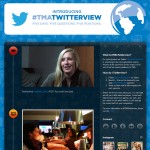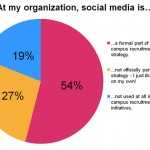You’ll meet thousands of students on-campus during the campus recruitment period this fall, have some really meaningful conversations about your organization…and then what?
It’s essential that you are able to transfer those encounters with students to ongoing engagement with you and your organization online so you can leverage those relationships throughout the year.
Ask students to follow you – on the spot
You have a captive audience, why not take advantage of it? Instead of simply telling students that they can follow you on Twitter, for example, start by asking whether they use Twitter or not. Then, ask them to pull out their smartphones and follow your organization on the spot using the Twitter apps on their phones.
While they’re typing and touchscreen-ing, you can explain what they’ll get in return, such as resume tips from recruiters like you, being the first to know when your roles go live, special guest tweeters like current interns, etc., and suggest ways they can get the most out of following you on Twitter.
If they’re not on Twitter, ask them why and use the discussion as an opportunity to learn about how else they might connect with your organization online. If you speak with enough students, you’ll likely be able to develop a good understanding of which types of students can be reached effectively through social media such as Twitter, and which cannot, allowing you to further target your online campus recruitment initiatives.
Go the extra mile – show off your social media handles: Add your Twitter handle, Facebook page name and LinkedIn group name to everything students will see on campus, including presentations. That way students can follow, like or join at any point during the information session or career fair, or make a note to themselves to check out your organization’s social media accounts when they get home.
Reference relevant online content in conversation
Brochures and business cards have their uses, but sometimes you need to show students a little more to help them understand what your organization does and what it’s like to work there, such as an article, video or employee testimonial.
For example, if a student asks what it’s like to start in an entry level role in one of your departments and you recently profiled a new grad employee from that exact department on your campus careers website, tell the student a few details about that employee’s experience and briefly explain how to find the full story on your website.
Or, for example, if they ask you what you love most about working for your organization and TalentEgg has recently published a video featuring student and recent grad employees answering that very same question, mention it and show it to them if you have time.
Go the extra mile – follow up on Twitter: Tell the student you’ll tweet the link and try to give a reasonable estimate as to when it will be posted, and then make a note for yourself to tweet about the content you discussed later that day so they can go back and find the link later, and hopefully share it with their own network as well.
Ask students what they think and collect their answers online
Students love giving feedback to employers – that’s something we realized as we recruited and collected responses from our Campus Recruitment Excellence Awards student judges earlier this year.
Ask students a question that you genuinely want to know the answer to, and find a way to collect their responses online. One of the easiest ways to do this is via a Facebook poll, but you could also ask a question on Twitter, run a poll on your website, etc.
You could ask a new question at each school, change it up once a week, or even keep the same question pinned to the top of your Facebook page’s timeline for the entire campus recruitment period.
Give them the personal touch
As you are notified of each new student follower, or when students tag you on Twitter after meeting you on campus, make an effort to send them a tweet to thank them for following you or for coming to speak with you on campus. By interacting with students directly and initiating the contact, students will definitely remember you and your organization over others.
If you find the volume or distractions overwhelming: Set your own best practices. For example, say that you’ll personally respond to your 10 newest followers at the beginning or end of each day. Each tweet will only take a few seconds and you can easily send out 10 in two or three minutes.
What are your best practices for taking student relationships from on-campus to online?






0 Comments
1 Pingback